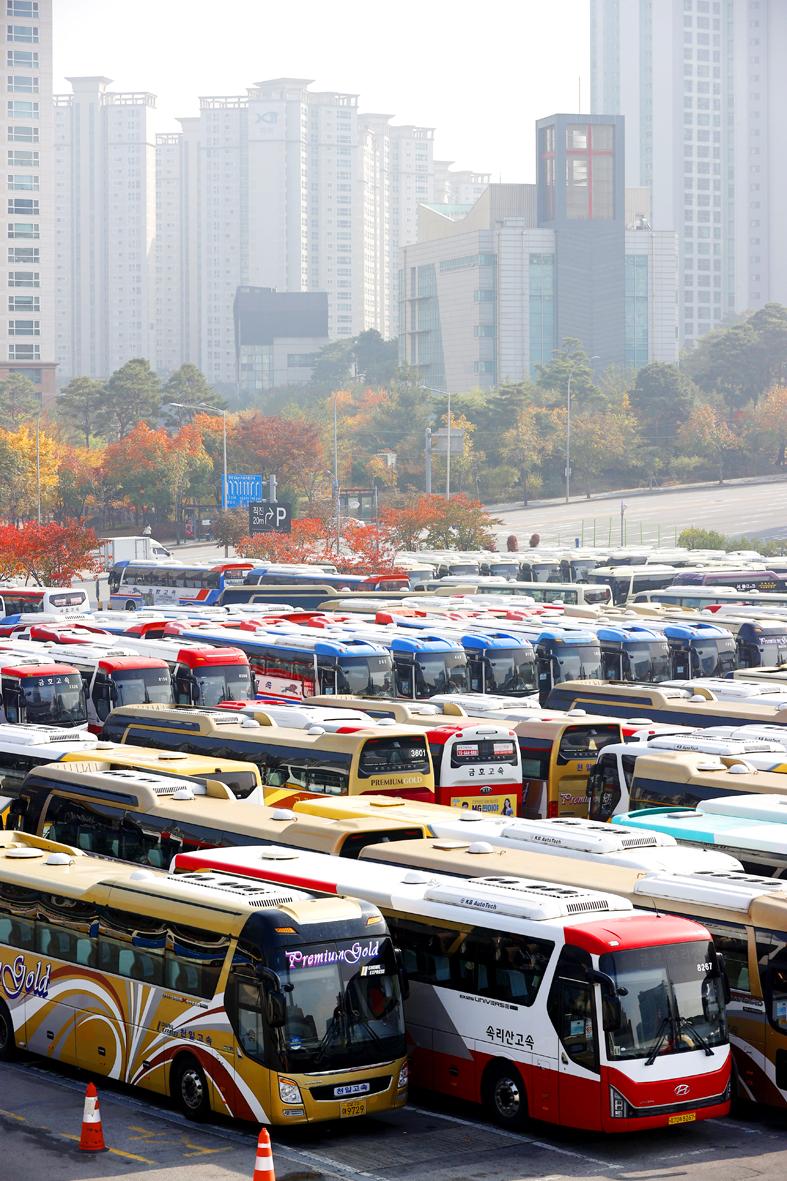South Korean drivers are panic buying urea, an additive used in diesel vehicles to reduce emissions, after China tightened exports, prompting the president’s office to set up a task force on Friday to negotiate supplies from producer states like China.
Diesel cars represented 40 percent of registered motor vehicles in South Korea as of August, government data showed, after South Korea in 2015 made it mandatory for diesel cars to use urea solutions to control emissions.
South Korea is heavily reliant on China for urea. About 97 percent of imports came from China between January and September, up about 8 percent from a year earlier, the South Korean Ministry of Trade, Industry and Energy said.

Photo: EPA-EFE
China’s customs announcement last month of inspection certificates to ship fertilizer and related materials like urea, a type of nitrogen mainly used as a fertilizer in agriculture, was considered a de facto ban on exports to assure supplies in its domestic market.
Prices of industrial urea in South Korea jumped more than 80 percent to US$483 per tonne in September from October last year, the trade ministry said.
A barrel of urea solution that used to cost 10,000 won (US$8.46) per 10 liters was being traded at as much as 120,000 won on online second-hand markets, local media reports said.
Desperate South Korean drivers looking for urea solutions, also known as diesel exhaust fluid, were sharing locations of gas stations that still had inventory, while those who had stocked up ahead were selling at steep markups.
Local broadcasters featured gas stations that put up signs that read “Urea solution SOLD OUT.”
“I cannot move out my SUV ... picnics can be canceled, it’s okay, but what if container trucks, fire engines, ambulances have to stop?” a diesel trader asked.
“For my SUV, I can fill 15 to 20 liters of additive in one shot and can run 3,000km to 5,000km, but heavy duty vehicles consume more,” he said, adding that this could be a bigger problem in the heavy trucking sector.
“It could decrease diesel consumption nationwide, if the situation goes worse,” he said.
South Korea’s presidential office on Friday set up a task force to ensure adequate supply of urea and initiate diplomatic consultation with producer countries like China, presidential press secretary Park Soo-hyun said in a statement.
Diversifying supply would not be easy as South Korea has become far too dependent on China, an official at a major South Korean urea suppliers said.
“We have signed contracts with Russia in October and it is only going to arrive in January. Yet again they are only about 10 percent of what we used to get from China,” the official said.
Inventory is likely to be depleted after this month, he added.
Other commodities:
‧Gold for December delivery rose US$23.30 to US$1,816.80 an ounce, gaining 1.84 percent from a week earlier.
‧Silver for December delivery rose US$0.25 to US$24.16 an ounce, up 0.88 percent weekly, while December copper rose US$0.02 to US$4.34 a pound.
Additional reporting by AP

The US dollar was trading at NT$29.7 at 10am today on the Taipei Foreign Exchange, as the New Taiwan dollar gained NT$1.364 from the previous close last week. The NT dollar continued to rise today, after surging 3.07 percent on Friday. After opening at NT$30.91, the NT dollar gained more than NT$1 in just 15 minutes, briefly passing the NT$30 mark. Before the US Department of the Treasury's semi-annual currency report came out, expectations that the NT dollar would keep rising were already building. The NT dollar on Friday closed at NT$31.064, up by NT$0.953 — a 3.07 percent single-day gain. Today,

‘SHORT TERM’: The local currency would likely remain strong in the near term, driven by anticipated US trade pressure, capital inflows and expectations of a US Fed rate cut The US dollar is expected to fall below NT$30 in the near term, as traders anticipate increased pressure from Washington for Taiwan to allow the New Taiwan dollar to appreciate, Cathay United Bank (國泰世華銀行) chief economist Lin Chi-chao (林啟超) said. Following a sharp drop in the greenback against the NT dollar on Friday, Lin told the Central News Agency that the local currency is likely to remain strong in the short term, driven in part by market psychology surrounding anticipated US policy pressure. On Friday, the US dollar fell NT$0.953, or 3.07 percent, closing at NT$31.064 — its lowest level since Jan.

Hong Kong authorities ramped up sales of the local dollar as the greenback’s slide threatened the foreign-exchange peg. The Hong Kong Monetary Authority (HKMA) sold a record HK$60.5 billion (US$7.8 billion) of the city’s currency, according to an alert sent on its Bloomberg page yesterday in Asia, after it tested the upper end of its trading band. That added to the HK$56.1 billion of sales versus the greenback since Friday. The rapid intervention signals efforts from the city’s authorities to limit the local currency’s moves within its HK$7.75 to HK$7.85 per US dollar trading band. Heavy sales of the local dollar by

The Financial Supervisory Commission (FSC) yesterday met with some of the nation’s largest insurance companies as a skyrocketing New Taiwan dollar piles pressure on their hundreds of billions of dollars in US bond investments. The commission has asked some life insurance firms, among the biggest Asian holders of US debt, to discuss how the rapidly strengthening NT dollar has impacted their operations, people familiar with the matter said. The meeting took place as the NT dollar jumped as much as 5 percent yesterday, its biggest intraday gain in more than three decades. The local currency surged as exporters rushed to